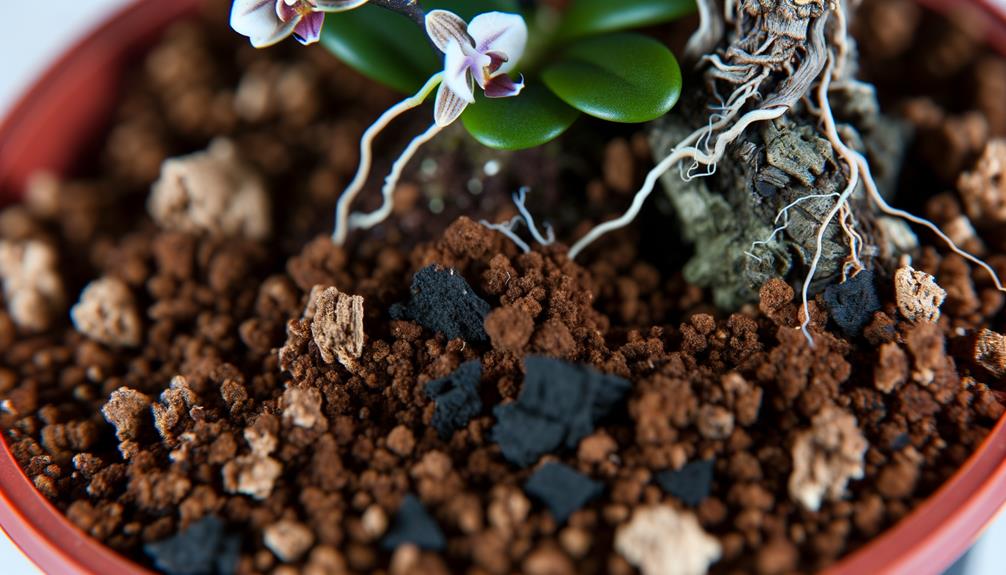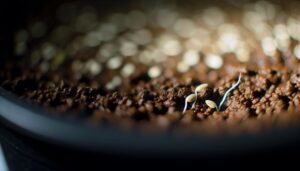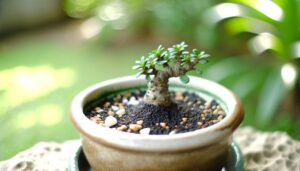5 Essential Tips for Using Orchid Soil in Bonsai Care
Using orchid soil for bonsai trees is possible but demands careful consideration and modification. Orchid soil primarily consists of bark, perlite, charcoal, and sphagnum moss, crafted for excellent drainage and aeration.
However, for bonsai, which need quick water flow and reduced moisture retention, incorporating inorganic materials like akadama, pumice, and lava rock into orchid soil is necessary. This guarantees efficient water drainage, optimal root oxygenation, and minimizes the risk of root rot.
Adjusting nutrient retention and pH levels are also essential for bonsai health. Understanding these specifics can greatly improve your bonsai's overall growth and well-being.

Key Takeaways
- Orchid soil retains more moisture than ideal for bonsai, necessitating modifications with inorganic materials.
- Bonsai trees require soil with rapid water percolation and excellent aeration to prevent root rot.
- Orchid soil components ensure aeration but may not provide the necessary nutrient retention for bonsai.
- Adjusting the pH of orchid soil may be necessary to match the ideal 5.5 to 6.5 range for bonsai.
- Custom soil mixes with akadama, pumice, and lava rock better meet bonsai soil requirements.
Understanding Orchid Soil

Orchid soil, also known as orchid substrate or orchid mix, is a specialized growing medium formulated to meet the unique requirements of epiphytic orchids, which differ greatly from terrestrial plant soils. This medium typically consists of a blend of bark, perlite, charcoal, and sphagnum moss, designed to provide excellent aeration and rapid drainage.
Epiphytic orchids naturally grow on trees, relying on air and rain for moisture and nutrients. As a result, the substrate must replicate these conditions by offering minimal water retention and preventing root rot. Research indicates that the coarse, loose texture of orchid soil promotes root oxygenation and reduces pathogen proliferation.
These attributes are crucial for maintaining the delicate balance of moisture and airflow essential for orchid health and vitality.
Characteristics of Bonsai Soil
Frequently, bonsai soil is characterized by its ability to provide excellent drainage and aeration while retaining sufficient moisture to support the plant's intricate root system. This soil's composition typically includes inorganic substrates such as akadama, pumice, and lava rock, which prevent compaction and guarantee root oxygenation.
Organic components, though minimal, such as pine bark, contribute to moisture retention without waterlogging. The granular nature of bonsai soil facilitates rapid water percolation, mitigating root rot risks. Additionally, the substrate's particle size is essential; it must be small enough to support fine root growth yet large enough to avoid clogging.
Such precise balance in soil characteristics is crucial for the health and vigor of bonsai trees, reflecting their unique horticultural demands.
Comparing Soil Components

Understanding the distinct components of bonsai soil and their roles is fundamental to evaluating how different soil types, such as orchid soil, can be adapted for bonsai cultivation. Bonsai soil typically comprises a blend of inorganic and organic materials, each contributing unique properties essential for tree health.
In contrast, orchid soil is designed for epiphytic plants, emphasizing aeration and moisture retention. Key bonsai soil components include:
- Akadama: A hard-baked clay that retains water and nutrients while allowing for root expansion.
- Pumice: A lightweight volcanic rock that improves soil structure and drainage.
- Lava rock: Enhances aeration and prevents soil compaction.
- Organic matter (e.g., pine bark): Provides nutrients and aids in water retention.
Understanding these components aids in determining if orchid soil can be modified to meet bonsai requirements.
Drainage and Aeration
How do drainage and aeration properties of orchid soil compare to those required for ideal bonsai cultivation?
Orchid soil, typically composed of bark, perlite, and sphagnum moss, is engineered for superior drainage and aeration to accommodate orchid roots, which are prone to root rot in stagnant water.
Similarly, bonsai trees necessitate a substrate that guarantees efficient water drainage and ample air circulation to prevent root decay and promote vigorous growth.
Research indicates that while orchid soil's composition facilitates these conditions, its high organic content may retain more moisture than desired for certain bonsai species.
Consequently, modifications such as integrating more inorganic materials like akadama or pumice might be necessary to align the soil properties precisely with the specific drainage and aeration needs of bonsai cultivation.
Nutrient Retention

Nutrient retention in orchid soil, characterized by its composition of organic and inorganic components, plays an important role in sustaining the health and growth of bonsai trees. Orchid soil typically includes bark, perlite, charcoal, and sphagnum moss, each contributing uniquely to nutrient dynamics.
- Bark: Provides slow decomposition, gradually releasing nutrients.
- Perlite: Enhances soil aeration while retaining minimal nutrients.
- Charcoal: Adsorbs impurities, maintaining soil health.
- Sphagnum Moss: Retains moisture and nutrients effectively.
These components create a medium that balances nutrient availability and retention, crucial for bonsai health.
However, the specific nutrient needs of bonsai trees may necessitate supplemental fertilization. Understanding how each element of orchid soil contributes to nutrient retention can guide appropriate fertilization practices, ensuring optimal bonsai growth and vitality.
Watering Requirements
When using orchid soil for bonsai, understanding the specific watering requirements becomes vital due to the medium's distinct properties. Research indicates that orchid soil maintains higher moisture levels compared to traditional bonsai substrates, necessitating adjustments in watering frequency to prevent root rot.
Precise monitoring of soil moisture levels is essential to guarantee ideal hydration and promote healthy root development.
Soil Moisture Levels
Maintaining ideal soil moisture levels in orchid soil for bonsai is essential to ensuring proper hydration and preventing root rot. Orchid soil, characterized by its high porosity and excellent drainage, offers unique moisture retention properties that influence bonsai tree health. Research indicates the importance of balancing water retention with aeration to avoid the detrimental effects of waterlogged roots.
Key considerations include:
- Water Retention Capacity: Orchid soil typically retains less water compared to traditional bonsai soil.
- Aeration: Enhanced air circulation around roots, reducing the risk of fungal infections.
- Drainage: Superior drainage properties, essential for preventing water stagnation.
- Soil Composition: Usually a blend of bark, perlite, and sphagnum moss that affects moisture levels.
Understanding these factors is vital for optimizing bonsai soil moisture management.
Watering Frequency
Determining the appropriate watering frequency for bonsai trees planted in orchid soil requires a thorough understanding of the soil's unique drainage and moisture retention characteristics. Orchid soil, mainly composed of materials such as bark, perlite, and sphagnum moss, offers excellent aeration and drainage compared to traditional bonsai substrates. This composition results in faster drying times, requiring more frequent watering.
However, the specific frequency should be adjusted based on environmental factors like humidity, temperature, and light exposure. Observations suggest that daily watering might be necessary during peak growth periods in warm climates, while every other day could be sufficient in cooler conditions.
Monitoring soil moisture levels using a moisture meter can provide accurate data, ensuring ideal hydration without risking root rot.
Root Health

Ensuring peak root health in bonsai trees involves understanding the specific nutrient and aeration requirements provided by orchid soil. Orchid soil, typically composed of bark, perlite, and sphagnum moss, offers several benefits for bonsai root systems:
- Aeration: The coarse texture of orchid soil promotes excellent aeration, preventing root rot by facilitating oxygen exchange.
- Drainage: Superior drainage properties help avoid waterlogged conditions, which can cause root decay.
- Moisture Retention: Sphagnum moss retains moisture without becoming waterlogged, maintaining a balanced hydration level.
- Nutrient Supply: While generally low in nutrients, orchid soil allows for controlled fertilization, ensuring the roots receive essential minerals without risk of nutrient burn.
Understanding these aspects is vital for maintaining robust root health in bonsai trees.
Soil Ph Levels
Understanding soil pH levels is essential for maximizing the health of bonsai trees. The ideal pH range facilitates nutrient availability and root function. Accurate pH testing methods, such as using electronic pH meters or pH test strips, guarantee precise monitoring of soil conditions.
Additionally, pH adjustment tips enable fine-tuning to maintain ideal growth environments. For instance, the use of lime can increase pH, while sulfur can decrease it.
Ideal Ph Range
The perfect pH range for orchid soil used in bonsai cultivation typically falls between 5.5 and 6.5, providing a balanced balance for nutrient availability and root health. This specific pH range ensures that essential nutrients such as nitrogen, phosphorus, and potassium are readily available for uptake, which is essential for the best growth and development of bonsai trees.
Key benefits of maintaining this pH range include:
- Enhanced nutrient absorption: Ensures essential nutrients are soluble and accessible.
- Improved microbial activity: Fosters beneficial microorganisms that aid in nutrient breakdown.
- Best root health: Prevents root damage from overly acidic or alkaline conditions.
- Stable soil structure: Maintains integrity and aeration, important for bonsai roots.
Understanding and maintaining the ideal pH range is crucial for successful bonsai cultivation using orchid soil.
Ph Testing Methods
Accurate pH testing methods are crucial for determining the soil pH levels to achieve ideal conditions for bonsai health and growth when using orchid soil. Employing a soil pH meter, which uses a probe to measure the hydrogen ion activity in the soil, provides immediate and precise readings.
Alternatively, laboratory soil tests offer thorough analyses, identifying not just pH but also nutrient imbalances. For a cost-effective approach, pH testing kits with color-changing reagents can be utilized; these provide visual indicators of pH levels.
Consistent monitoring, using any of these methods, ensures that the pH remains within the best range (typically 5.5 to 7.0) for bonsai, facilitating proper nutrient absorption and overall plant vitality.
Ph Adjustment Tips
Adjusting soil pH levels for bonsai requires a systematic approach, utilizing both organic and inorganic amendments to achieve the most suitable range for nutrient absorption and plant health. Ideal pH levels for bonsai typically range between 6.0 and 7.0.
To fine-tune pH levels, consider the following adjustments:
- Sulfur: Incorporating elemental sulfur can effectively lower soil pH over time through microbial oxidation.
- Lime: Adding agricultural lime (calcium carbonate) raises soil pH by neutralizing acidity.
- Peat Moss: Utilizing peat moss can help to lower pH levels and improve soil aeration.
- Dolomitic Lime: This compound not only raises pH but also supplies magnesium, an essential micronutrient.
Common Soil Additives

Incorporating common soil additives such as perlite, akadama, and pumice can greatly enhance the structural integrity and nutrient profile of orchid soil when used for bonsai cultivation.
Perlite, a volcanic glass, improves aeration and drainage by maintaining a porous structure.
Akadama, a Japanese clay, offers excellent water retention and cation exchange capacity, enabling efficient nutrient uptake.
Pumice, a type of volcanic rock, provides a lightweight, well-draining medium that prevents root rot.
These additives collectively guarantee optimal root health by balancing moisture retention and aeration, essential for the delicate root systems of bonsai trees.
Research indicates that integrating these components into orchid soil can create a more suitable growth environment, promoting robust development and longevity for bonsai specimens.
Custom Soil Mixes
Crafting custom soil mixes for bonsai requires a nuanced understanding of the specific needs of various bonsai species and the environmental conditions in which they are cultivated. Key components of a well-balanced bonsai soil mix include inorganic and organic materials that optimize drainage, aeration, and nutrient availability.
Research indicates that a successful custom mix should consider:
- Particle size: Promotes root oxygenation and prevents compaction.
- Water retention: Ensures adequate moisture without waterlogging.
- Nutrient content: Supplies essential minerals for growth.
- pH balance: Matches the species-specific requirements to avoid nutrient deficiencies or toxicities.
Expert Opinions

Experts in horticulture have identified key differences in the soil composition of orchid media compared to traditional bonsai substrates, which can greatly impact plant health.
Research indicates that the high aeration and moisture retention properties of orchid soil can either benefit or hinder bonsai growth depending on species-specific requirements.
This discourse will evaluate the implications of using orchid soil for bonsai, highlighting both positive and negative effects on plant health.
Soil Composition Differences
The soil composition used for bonsai cultivation varies significantly from that of orchids. Experts highlight differences in particle size, organic matter content, and water retention properties. Bonsai soil requires a precise balance to support root aeration and controlled water retention, whereas orchid soil focuses more on high drainage and airflow.
- Particle Size: Bonsai soil typically features smaller particles to maintain moisture while allowing for gas exchange.
- Organic Matter Content: Bonsai mixes often have reduced organic matter compared to orchid substrates, preventing excessive moisture retention.
- Water Retention: Bonsai soils are engineered to retain water sufficiently without becoming waterlogged, essential for root health.
- Soil Components: Common bonsai soil components include akadama, pumice, and lava rock, contrasting with the bark and sphagnum moss used in orchid mixes.
Plant Health Impacts
When considering plant health impacts, utilizing orchid soil for bonsai trees can lead to significant challenges due to the discrepancies in water retention and aeration requirements between the two plant types.
Expert horticulturists emphasize that orchid soil, typically composed of bark, perlite, and sphagnum moss, offers superior aeration but insufficient moisture retention for most bonsai species.
Bonsai trees generally require a balanced substrate facilitating both adequate drainage and moisture retention. Research indicates that improper soil composition can lead to root desiccation or waterlogging, both detrimental to bonsai health.
Moreover, the unique pH levels and nutrient profiles of orchid soil may not align with the specific needs of bonsai species, potentially leading to nutrient imbalances and impaired growth.
Practical Tips
To attain optimal growth conditions for bonsai trees, utilizing a well-balanced orchid soil mix can greatly enhance root aeration and moisture retention. This combination is particularly beneficial for bonsai species that flourish in well-draining substrates.
Here are some practical tips to optimize the use of orchid soil for bonsai cultivation:
- Soil Composition: Incorporate components like pine bark, perlite, and sphagnum moss for balanced drainage and moisture.
- Watering Schedule: Adjust watering frequency based on the increased aeration properties of orchid soil to prevent over-watering.
- Fertilization: Use a balanced, slow-release fertilizer to provide essential nutrients without overwhelming the roots.
- Repotting Frequency: Monitor root growth and repot every 1-2 years to maintain soil structure and nutrient availability.
These strategies ensure a thriving bonsai environment.
Conclusion
Bonsai soil's characteristics, such as excellent drainage, ideal aeration, and balanced nutrient retention, differ from orchid soil's organic composition and moisture retention properties.
Despite some shared elements like bark and perlite, the distinct requirements of bonsai necessitate a custom soil mix.
Expert opinions underscore the importance of precise soil composition tailored to specific plant needs.
Practical tips emphasize the significance of selecting suitable soil additives to guarantee the health and essentiality of bonsai trees.






